If you’re new to fermentation, you may not realize how important choosing the right salt can be for your success. With so many different types of salt available, it can be overwhelming to know which one to choose. In this post, we’ll explore the various types of salt commonly used for fermentation and help you determine which one will give you the greatest success.
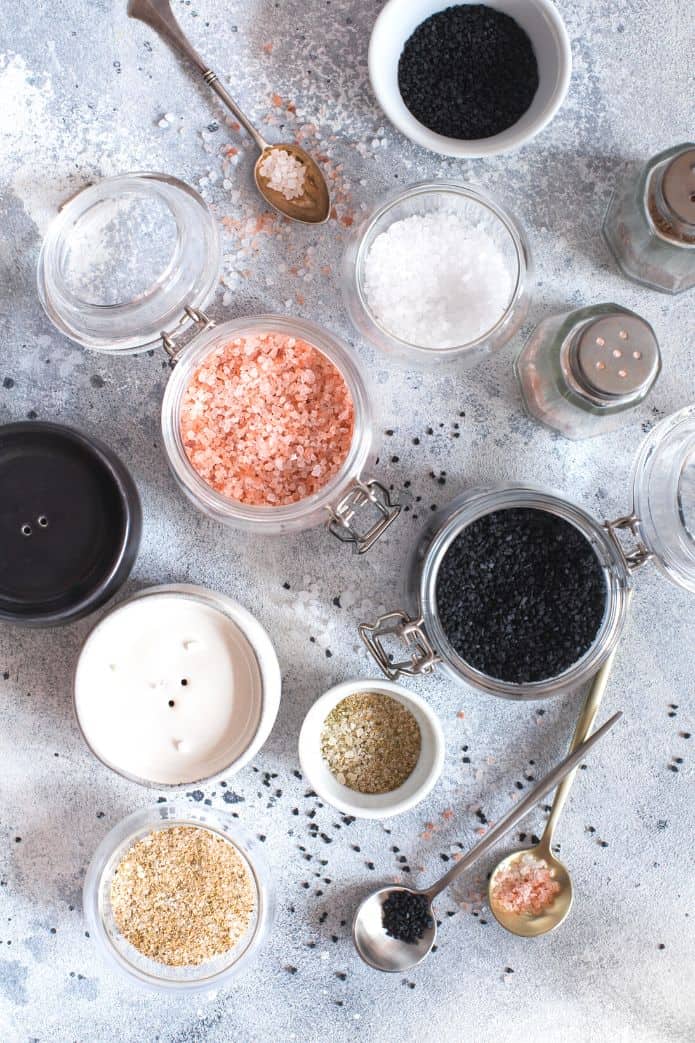
Today, I’m going to ensure that you are successful with fermentation and share with you what salt I’ve had the most consistent results with.
Over twenty-plus years of fermenting various vegetables, relishes, kimchi, and sauerkraut, I’ve tried just about every type of salt out there.
What is the best salt for fermentation?
I recommend Himalayan Pink Salt or Real Salt®, mineral-rich dry salts that have not been stripped of their naturally occurring minerals.
You can also ferment with refined salts that do not contain additives such as calcium silicate or potassium iodide. Check the label. It should only list “sodium chloride.”
Read further for additional details on the importance of salt for fermentation and why I use Himalayan Pink Salt.
Let’s dive in right now.
FREE PDF Download
Use the button below to grab my handy Best Salt & How Much Salt PDF.
Why Use Salt?
Salt is used to create the brine in which vegetables ferment.
For sauerkraut, salt pulls water out of the cabbage to create an environment where the good bacteria (mainly lactobacillus) can grow and proliferate, and the harmful bacteria can die off.
For brined vegetables (e.g., cucumber pickles), the water from inside the cucumber will flow out until the water inside and outside the cucumber are equally salty. As the cucumber loses the water inside it, it shrivels up and shrinks, becoming a pickle.
This is an essential job for our salt! Make it a good one.
Now, let’s learn what your salt choices are.
Three Categories of Salt
I’ve grouped salt choices into three categories:
- Processed salts (table salt, sea salt, iodized salt, kosher salt, and pickling salt), some of which don’t contain additives. Though not ideal, these salts generally work. If processed salts are all you have, use them until you’re able to upgrade to a mineral-rich dry salt.
- Mineral-rich dry salts (Himalayan Pink and Redmond Real Salt®) that contain naturally occurring minerals are good to switch to once you’re ready to spend the extra money for the extra minerals these salts contain. The best salt for fermentation is a mineral-rich dry salt.
- Mineral-rich wet salts (grey sea salt) contain naturally occurring minerals and a high moisture content that can affect salt concentration.
I no longer recommend this category of salts since they can contain microplastics, lead, and heavy metals due to the high levels of pollution in our waters today.
Processed Salts
When you think of salt, the white stuff in your shaker on the table comes to mind. You may know it as table salt, sea salt, kosher salt, or pickling salt.
However, few people realize that salt—like sugar, flour, and vegetable oils—is highly refined.
It is the product of an industrial process that uses chemicals and high temperatures to remove all the trace minerals naturally occurring in the sea or earth. The minerals are then sold to companies that make and sell dietary supplements.
These are the minerals that our bodies use to regulate blood pressure, nourish our adrenals, and keep us healthy, and that bacteria can use during fermentation.
This is my take, but there are other perspectives to muddy the waters, as one of my readers shared.
As a former farmer who has spent lots of time studing nutrition for cattle and other farm animals I learned a lot about what works and what is a waste of money. Mineral content in salt used for fermentation is going to be useless. We have to have the minerals in a chelated form in order for our bodies, and the bacteria in our digestive tracts, to utilize them.
Remember that we don’t “digest” and utilize the food we eat. We eat the food and the bacteria in our system “digests” the food and we absorb the bacteria. If you are wanting to receive the benefits of minerals in a raw form then the best application would be to put those minerals into the soil that the cabbage and carrots etc. are growing and the plants will chelate the minerals for us. We can then utilize those minerals when we eat the plants. Pure salt is the best thing to use for fermentation and curing.
—Dale
Table Salt or Iodized Salt—Do Not Use
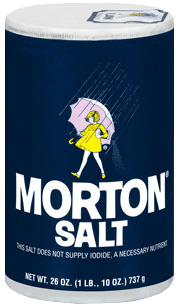
These are salts that you can buy inexpensively from any grocery store.
They are refined salts that have had all their minerals stripped out during processing. They also contain additives such as calcium silicate to make them free-flowing and potassium iodide to compensate for iodine deficiencies. The Windsor brand of table salt is available here in Canada, and sugar is even listed on the label!
The problem with these additives is that they may inhibit the beneficial bacteria in your fermenting sauerkraut. Because of this, I do not recommend using table salt or iodized salt for fermentation.
Industrial Sea Salt—Check the Label
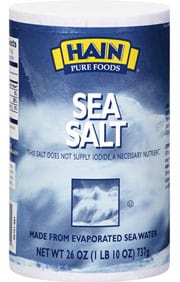
Most so-called sea salt is produced by industrial methods. It ends up being a highly refined salt that has had all its minerals stripped out during processing, just like table salt.
Even if it does not contain all of its minerals, as long as there are no additives listed on the label, it is OK to use for fermenting.
Kosher Salt—Not Recommended
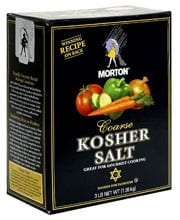
This is also a popular salt found in most grocery stores.
Kosher salt is not “kosher” itself but is used to make kosher meats. It has a larger crystal than table salt.
I don’t recommend using it for fermentation because the larger crystals don’t dissolve as quickly as fine-grain salt. It can also contain anti-caking agents that you don’t want in your ferments.
Pickling Salt—Works Fine
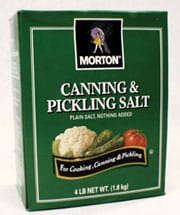
Pickling salt does not contain anti-caking ingredients or additives like iodine.
Pickling salt is pure granulated salt (sodium chloride), whose granules are designed to dissolve quickly.
Mineral-Rich Dry Salts
Think of salt as any other food you would put on the table or in your ferments. An ideal salt for fermenting is whole, unrefined, and full of natural vitamins and minerals.
Mineral-rich dry salts are mined from ancient sea beds, Pakistan for the Himalayan Pink Salt and Utah for Real Salt®.
Himalayan Pink Salt—My Favorite
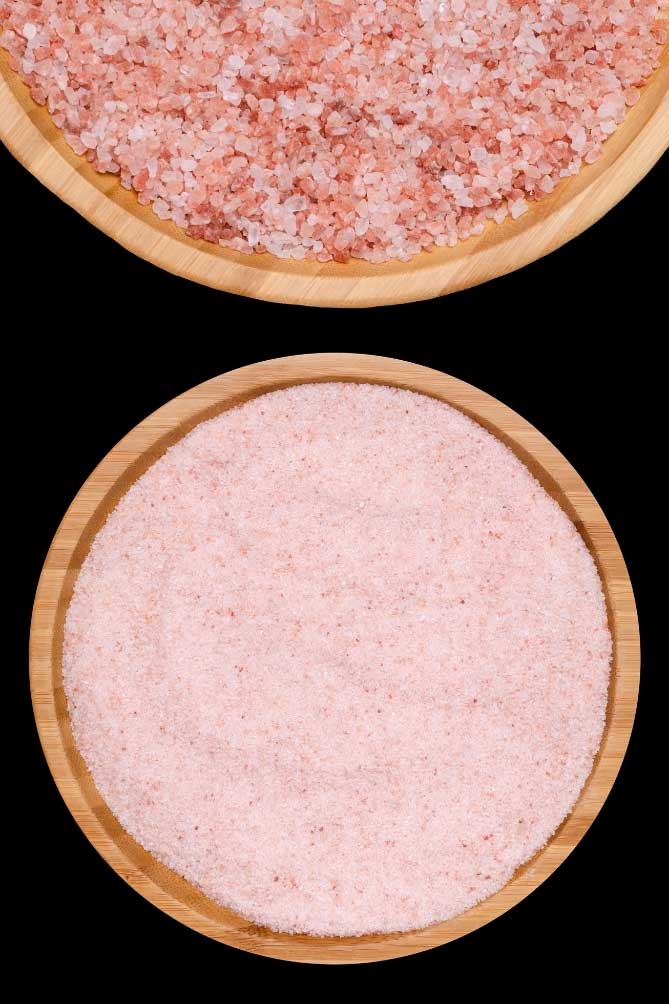
Himalayan Pink Salt is my favorite salt to ferment with.
Its purity and high mineral profile ensure a healthy fermentation environment. I especially like its color—a beautiful pink! Himalayan Pink Salt is mined from deep in the Himalayan Mountains.
This salt crystallized more than 200 million years ago and remains protected from modern-day pollution and impurities.
It contains more than 84 trace minerals and none of the additives or aluminum compounds in refined table salt.
I like to use unprocessed ingredients; thus, my preference for mineral salts or
unprocessed sea salts.
Lead in Himalayan pink salt?
However, some choose not to use salts mined from ancient sea beds (Himalayan pink salt and Real Salt®) due to trace amounts of lead in these subterranean salt mines and instead recommend sea salt.
I’m more disturbed by the microplastics in our sea waters and how varying moisture contents can affect sodium numbers.
This article sums up my viewpoint on why the benefits of Himalayan salt outweigh the negative factors.
- 100% CERTIFIED AND NATURAL: Does not contain any pieces of plastic like some of our...
- USED: Seasoning for grilled meats, fish, ribs, eggs, vegetables, soups, stews, pasta salads as...
- INGREDIENTS AND MINERALS: Himalayan pink salt ranges in color from sheer white to varying...
- Our Sherpa Pink Himalayan Salt is Kosher Certified, Non-GMO, and does not contain any MSG, Soy,...
- This Sherpa Himalayan pink salt is in our slightly larger than standard table salt Fine Grain.
- Our 100% pure Himalayan Pink Salt is the perfect addition to any meal! Sherpa Pink Himalayan...
Redmond Real Salt®—Also a Good One
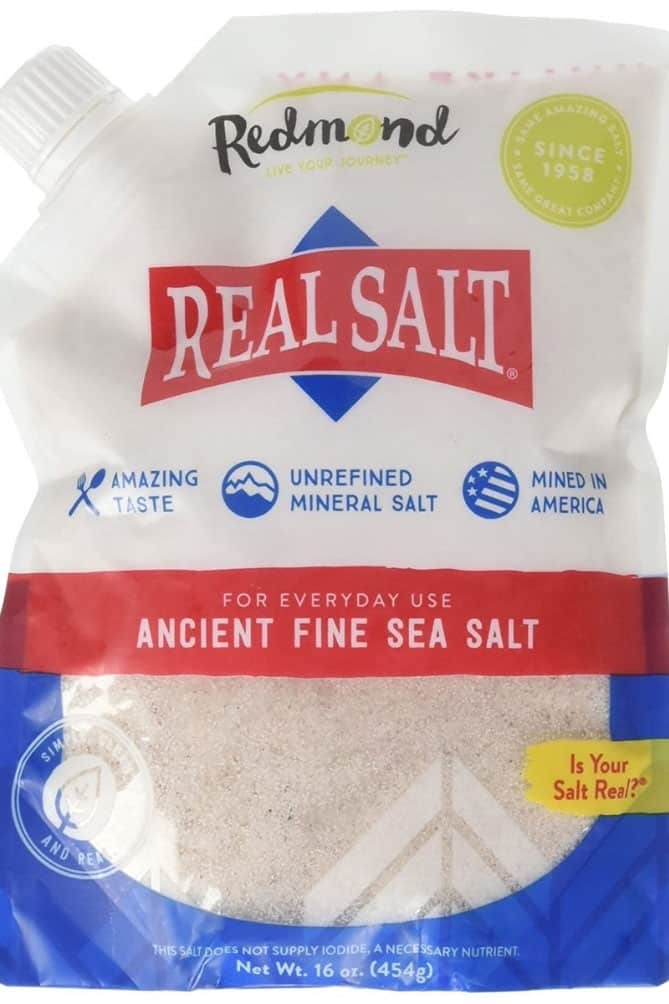
Redmond Real Salt is commonly found in health food stores and even in many standard grocery stores.
Real Salt® comes from an ancient sea bed in Central Utah. It is completely natural sea salt—nothing added, nothing removed. That means you get more than 60 trace minerals in a delicious, healthy salt that is not chemically treated, bleached, or kiln-dried.
- FLAVOR – Real Salt is unlike any salt on earth. It’s subtly sweet, never bitter sea salt...
- NATURAL – Unrefined, unprocessed and ancient sea salt with trace minerals and no additives....
- HEALTHY – Recommended by doctors! An ancient sea salt recommended by doctors and health...
Mineral-Rich Wet Salts
Grey Sea Salt—No Longer Recommended
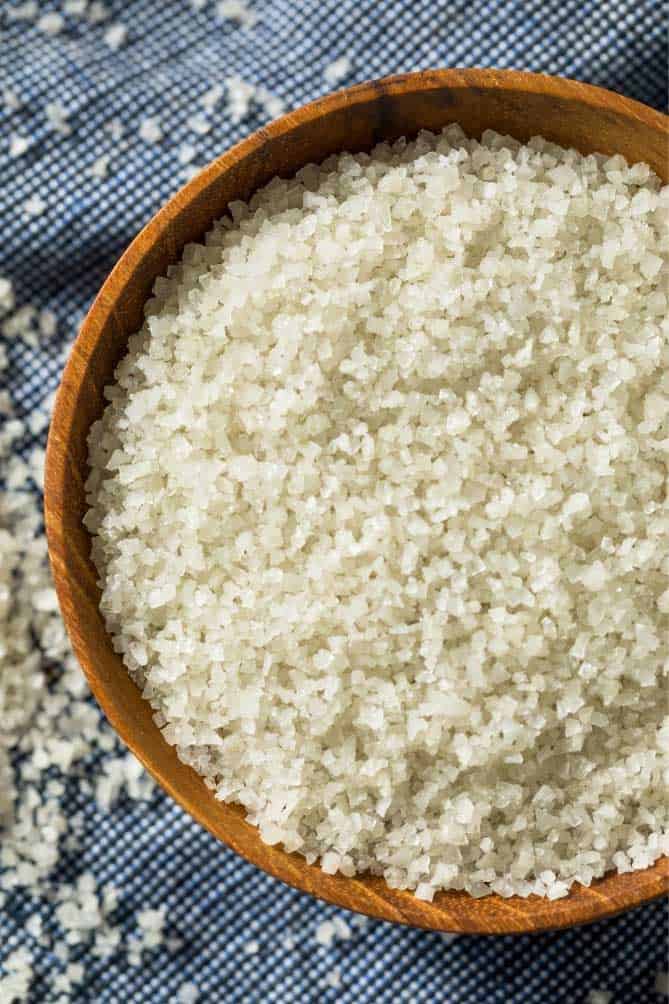
I used to ferment with grey sea salt because of its high mineral profile and availability at local health food stores.
The grey in this salt comes from the clay lining of the salt ponds where seawater is evaporated.
It is known for its high moisture content, extraordinary mineral content, and bonus nutrients not found in most sea salts. It is hand-harvested according to centuries-old Celtic methods and is often called Celtic Sea Salt.
It can contain lead and other heavy metals due to higher levels of pollution found in our waters today.
In addition, some claim that mold can form during the evaporation process, but it is not something you want to introduce into your ferment.
Summary of Salt Choices
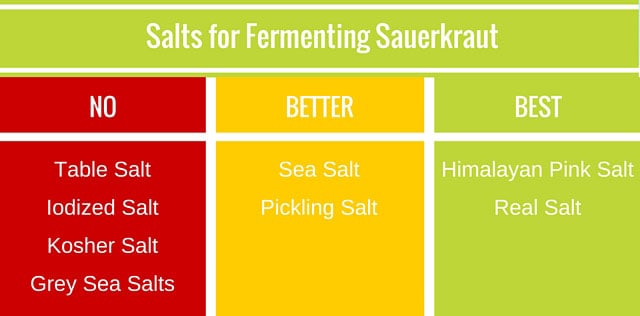
The best salt for fermentation is an unprocessed salt, a salt that still has its complete natural profile of minerals.
The two salts I use for fermenting sauerkraut and various vegetables are Himalayan Pink salt or Real Salt®.
One of the nutritional benefits of fermentation is that it makes minerals bioavailable, resulting in more nutritious sauerkraut. So, the more minerals in the salt you use, the more minerals you’ll end up within your sauerkraut.
However, if the only salt you have in your home is refined, go ahead and use it.
There is the “ideal,” and then there is reality.
In fact, having had the opportunity to ferment vegetables with every possible kind of salt handed to me by workshop organizers, I have observed that lactic acid bacteria seem tolerant to a wide variety of salts, including iodized salt, and are not particularly picky.
Sandor Katz, The Art of Fermentation
Start with what you have, and then, over time, “level up” your salt choice.
How Much Salt for Fermentation?
See How Much Salt Should I Use in My Lacto-Fermented Sauerkraut? or follow my step-by-step recipe:
Frequently Asked Questions about Fermenting Salt
“Fine” grains of salt will dissolve more quickly than larger grains and give you the best results.
If your grocery store has bulk bins, check there. One reader told me she could find it in the bins at Sprout Market.
Health food stores will likely carry Himalayan pink salt, which can also be found online.
Yes, but you’ll want to take the extra step to grind it first. Large salt grains do not always dissolve entirely and result in uneven disbursement of the salt.
Yes, pickling salt works fine. Its grains dissolve quickly, and it contains no additives.
Some of the minerals in these salts don’t dissolve in water. Some look like grains of sand, and some look like grains of salt. People sometimes notice traces of red minerals left behind too.
Most of the granules that don’t dissolve are the trace mineral silica, an element that occurs naturally in healthy bones and joints.
The amount of salt you use impacts the rate of fermentation. Too much salt slows fermentation down; not enough salt will cause fermentation to progress too quickly.
When used in the right proportions, salt creates an environment that allows us to better control the growth of microorganisms and have a happier ferment.
No, most likely, everything will ferment just fine. There is the “ideal” for “stacking the deck in your favor,” and then there is what you have in your kitchen. Don’t let your options prevent you from getting started with fermentation.
Know Your Salts Infographic
Here is a beautiful infographic by the Real Salt® Company that nicely summarizes your salt choices.
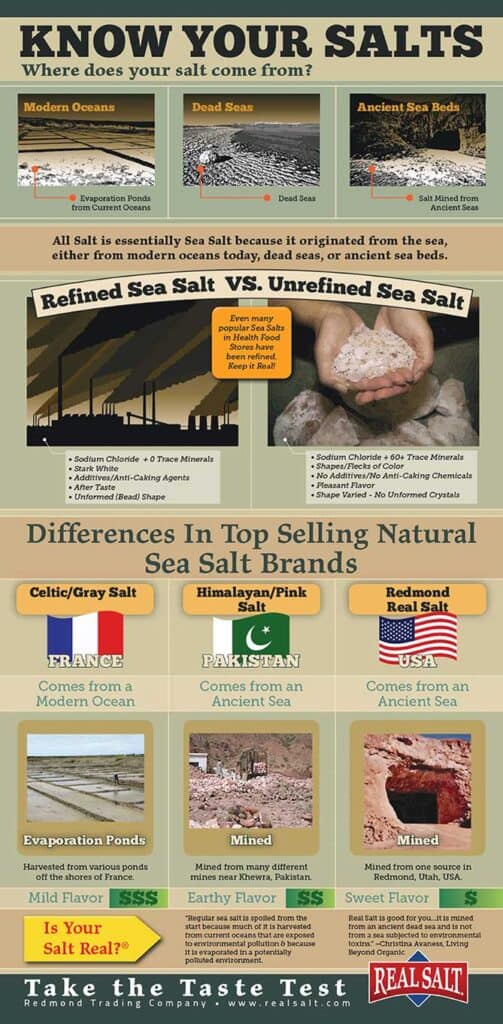
FREE PDF Download
Use the button below to grab my handy Best Salt & How Much Salt PDF.
What Salt Will You Use for Making Sauerkraut?
Share in the Comments section what salt you have around the house that you will use for fermenting.
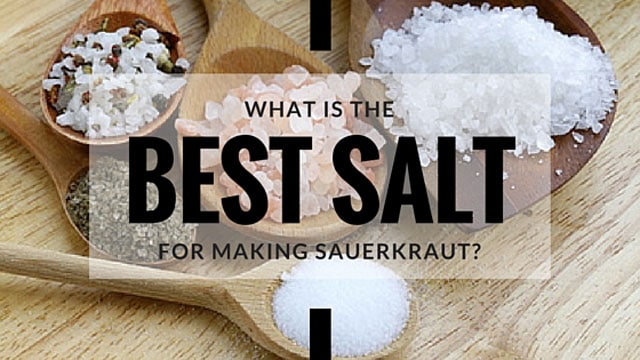
Last update on 2024-07-26 / Affiliate links / Images from Amazon Product Advertising API

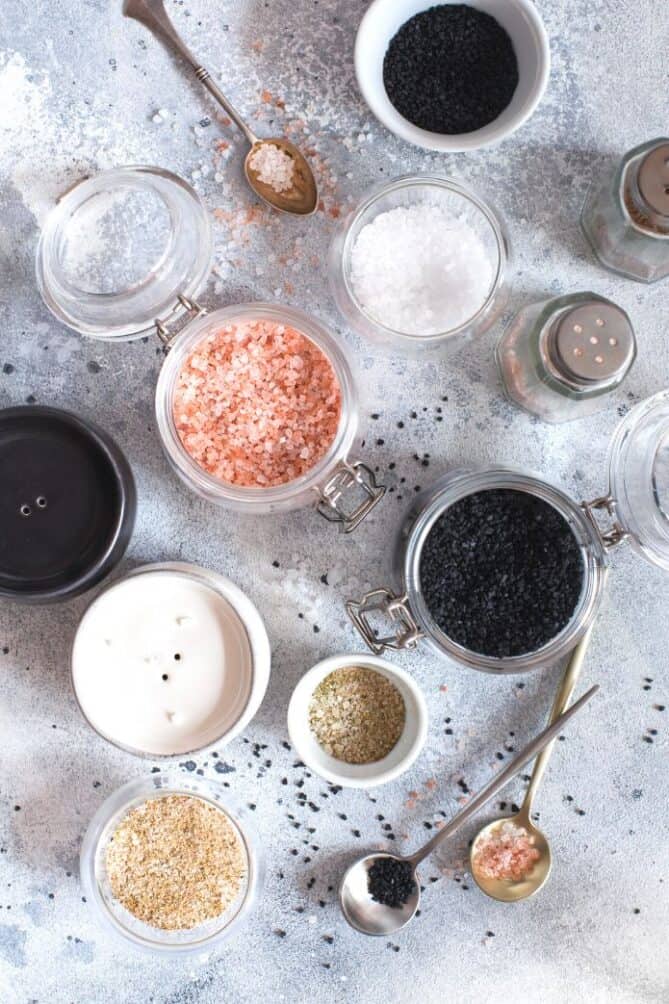

 This post may contain affiliate links which won’t change your price but will share some commission.
This post may contain affiliate links which won’t change your price but will share some commission.


